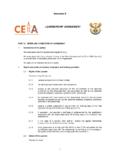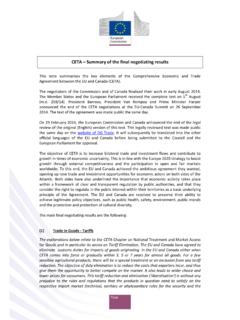Transcription of STRATEGIC PLAN OF THE CONSTRUCTION EDUCATION AND …
1 STRATEGIC PLAN OF THE CONSTRUCTION EDUCATION AND TRAINING AUTHORITY 2011 - 2016 JANUARY 2014 Page 2 FOREWORD The CETA STRATEGIC plan represents its programme of action in line with its vision to ensure quality EDUCATION and training to enhance the CONSTRUCTION sector s contribution to national economic growth and development. It is compiled in line with National Treasury Regulations. This plan takes into account the Medium Term STRATEGIC Framework (MTSF) and it reflects the outcomes of government. In terms of STRATEGIC goals, it responds specifically to the goals of NSDS III which is informed by MTSF2009-14 and articulates a strong focus on quality EDUCATION and sets high goals to address skills needs for designated groups and the provinces that are economically challenged. The corporate governance, corporate management and project management goals that are unique to the circumstances of the CONSTRUCTION SETA, are addressed.
2 Included in the STRATEGIC plan are strategies contributing to the achievement of the country s new economic growth and social development goals. The CETA s STRATEGIC plan is aligned to the following goals of the NSDS III: Establishing a credible mechanism for skills planning: Increasing access to occupationally-directed programmes: Promoting the growth of a public FET college system that is responsive to sector s skills needs and priorities: Addressing the low level of youth and adult language and numeracy skills to enable additional training: Encouraging better use of CONSTRUCTION workplaces for skills development: Encourage and support small enterprises (including non-profit organisations) cooperatives and worker-initiated training initiatives in the CONSTRUCTION Increasing, through CONSTRUCTION -related skills, public sector capacity for improved service delivery and supporting the building of a developmental Building career and vocational guidance for CONSTRUCTION : 4:8 Dr Bonginkosi Emmanuel Nzimande Signature: _____ Minister of Higher EDUCATION and Training Page 3 OFFICIAL SIGN OFF Page 4 CONTENTS FOREWORD 2 OFFICIAL SIGN OFF 3 GLOSSARY OF TERMS 5 PART A: STRATEGIC OVERVIEW 6 1.
3 Vision .. 6 2. Mission .. 6 3. Values .. 6 4. Legislative and other mandates .. 6 Constitutional mandates .. 6 Legislative mandates .. 6 Policy mandates .. 7 Relevant court rulings .. 9 Planned policy initiatives .. 9 5. Situational analysis ..10 Performance Environment ..10 Organisational Environment ..10 6. STRATEGIC OUTCOME ORIENTED GOALS OF THE CETA ..15 PART B : STRATEGIC GOALS AND OBJECTIVES 18 PART B: STRATEGIC OBJECTIVES 35 RESOURCE CONSIDERATION ..35 RISK MANAGEMENT ..35 PART C: LINKS TO OTHER PLANS 36 ANNEXURE A: OVERVIEW OF THE BUDGET AND MTEF ESTIMATES 40 ADMINISTRATION BUDGET BY PROGRAMME ..41 BUDGET PER STRATEGIC GOAL ..44 TECHNICAL INDICATORS AND DESCRIPTIONS 45 Page 5 GLOSSARY OF TERMS AET - Adult EDUCATION and Training; Apprenticeship - A trade qualification registered with an Industry Training Board in terms of the Manpower Training Act of 1981; Assessment - A structured process for gathering evidence and making judgments about an individual s performance in relation to registered, national standards; Board - The governing body / Accounting Authority of the CETA; Discretionary Grant - Grants paid out in terms of Regulation 6(3) (a) and (b) of the Skills Development Levies Act No 9 of 1999; DQP Development Quality Partner Employer - Employer as defined in the Fourth Schedule to the Income Tax Act; Funding Priorities - Skills Development priorities approved by the Board.
4 Further EDUCATION and Training (FET) - EDUCATION and training at Levels 2 to 4 of the National Qualifications Framework (NQF); Learnership - A vocational based learning qualification that includes a practical work-based component. A learnership has to be aligned with a registered NQF qualification; Learning Programme - A set of unit standards based learning activities intended to give a learner particular knowledge and skills; MTSF - Medium Term STRATEGIC -Planning Framework NQF - National Qualifications Framework; NSDS - National Skills Development Strategy; OFO - Organising Framework of Occupations codes PFMA - Public Finance Management Act, 1999; PIVOTAL - professional, vocational, technical and academic learning programmes that result in occupational qualifications and may include a knowledge component that is normally delivered at a further EDUCATION and training college or a university as well as structured learning in an accredited training centre or an approved workplace.
5 QCTO - Quality Council for Trades and Occupations QMS - Quality Management System as defined by the CETA; RPL - Recognition of Prior Learning by assessing competence against the outcomes of a set of unit standards; SAQA - South African Qualifications Authority established in terms of the South African Qualifications Authority Act, No. 58 of 1995; SDL - Skills Development Levy; Skills Programme - Occupationally based unit standard training programme, delivered by accredited EDUCATION and training providers. SLA - Service Level Agreement; SSP - Sector Skills Plan. Page 6 PART A: STRATEGIC OVERVIEW 1. Vision To be a firm pillar for skills for all in CONSTRUCTION and nation-building 2. Mission To create a solid skills base as a foundation for infrastructural development and economic empowerment 3.
6 Values Responsiveness Respect Integrity Professionalism 4. Legislative and other mandates Constitutional mandates Chapter II of Section 29(1) of the Bill of Rights as enshrined in the Constitution of the Republic of South Africa (1996) outlines that everyone has the right to:- o Basic EDUCATION , including adult EDUCATION and o To further EDUCATION which the State, through reasonable measures, must make progressively available and accessible The CONSTRUCTION EDUCATION and Training Authority as a public entity under the auspices of the Department of Higher EDUCATION and Training is thus mandated by law through the Constitution to fund and facilitate skills development in CONSTRUCTION Legislative mandates Section 10(1) of the Skills Development Act (Act 97 of 1998) provides that a SETA must o develop a sector skills plan within the framework of the national skills.
7 O development strategy; o implement its sector skills plan by establishing learnerships; approving workplace skills plans; allocating grants in the prescribed manner to employers; EDUCATION and training providers and workers; and monitoring EDUCATION and training in the sector; Page 7 promote Iearnerships by identifying workplaces for practical work experience; supporting the development of learning materials; improving the facilitation of learning; and assisting in the conclusion of Iearnership agreements register Iearnership agreements; within a week from its establishment, apply to the South African Qualifications Authority for accreditation as a body contemplated in section and must, within 18 months from the date of that application, be so accredited; collect and disburse the skills development levies in its sector requires SETAs to provides a framework to develop and improve the skills of South African workforce The Skills Development Levies Act (Act 9 of 1999) provides for imposition of skills development levy; and for matters connected therewith.
8 The CETA is thus mandated to fund skills development interventions in CONSTRUCTION The Public Finance Management Act (Act 1 of 1999, as amended by Act 29 of 1999) - regulates financial management in the national government and provincial governments to ensure that all revenue, expenditure, assets and liabilities of those governments are managed efficiently and effectively; to provide for the responsibilities of persons entrusted with financial management in those governments; and to provide for matters connected therewith The National Qualifications Framework Act (Act 67 of 2008) provides for qualification development framework and development of standards within quality assurance processes. This has led to the establishment of the Quality Council for Trades and Occupations (QCTO) Other laws impacting on the CETA s performance include but are not limited to: Broad Based Black Economic Empowerment Act (Act 53 of 2003) The Preferential Procurement Policy Framework Act (Act 5 of 2000) The Employment Equity Act (Act 55 of 1998) Policy mandates New Growth Path (NGP) The NGP sets a goal of five million new jobs by 2020 and points to specific sectors and to markets as job drivers.
9 It focuses on sectors that generate employment on a large scale. The Page 8 NGP requires a radical review of the training system to address shortfalls in artisanal and technical skills. It envisages improving the quality of EDUCATION , training and innovation. The STRATEGIC Integrated Projects (SIPs) are in line with the NGP. The CETA foresees even more improvement in the industry in the light of the SIPs. The NGP identifies the following levers for achieving job creation: Investment in infrastructure that will create jobs in four phases CONSTRUCTION of fixed assets, operation, maintenance and the manufacture of components required for CONSTRUCTION ; The selection of specific areas to promote employment, such as agriculture, agro-processing, tourism; The use of technology to generate jobs such as renewable energy projects in the quest for a green economy; Investment in social capital and public services, such as cooperatives, non-governmental organisations and stokvel; Promotion of regional development to boost the rural areas through roads, ports, linkages to other countries on the continent.
10 The emphasis is on infrastructural investment and the manufacture of components which will affect both contractors and material suppliers positively. An opportunity exists for the CETA to assist in the development of local people for employability where sector players are involved in large infrastructure projects, or where there are plans to deploy such programmes. The National Development Plan The National Development Plan (NDP) was introduced at the end of 2011 by the National Planning Commission. It focuses on the reduction of poverty and inequality and reiterates the objectives of the New Growth Path. It lays out the vision to be achieved by 2030. The most important aspect of the plan from the point of view of the CONSTRUCTION industry is the massive infrastructure investment. In the 2013 budget, the nation was assured that R827 billion would be drawn from the fiscus and state-owned enterprises to finance this.










